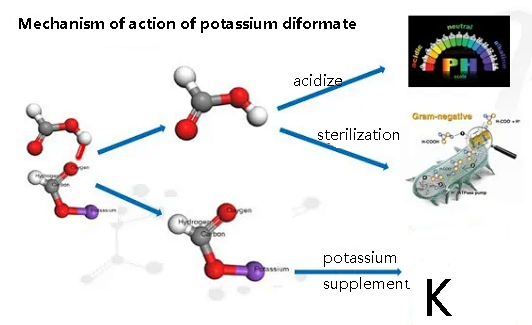Potassium diformate, as the first alternative anti growth agent launched by the European Union, has unique advantages in antibacterial and growth promotion. So, how does potassium diformate play a bactericidal role in the animal digestive tract?
Due to its molecular particularity, potassium diformate does not dissociate in acidic state, but only in neutral or alkaline environment to release formic acid.
As we all know, the pH in the stomach is a relatively low acidic environment, so potassium diformate can enter the intestine through the stomach by 85%. Of course, if the buffering capacity of the feed is strong, that is, the acid strength of the system we usually call is high, part of the potassium diformate will dissociate and release formic acid to play the effect of Acidifier, so the proportion reaching the intestine through the stomach will be reduced. In this case, potassium diformate is an acidifier! Therefore, in order to give play to the intestinal alternative antibacterial effect of potassium diformate, the premise is to reduce the acidity of the feed system, otherwise the addition amount of potassium diformate must be large and the addition cost will be high. This is the reason why the combined application of potassiumdiformate and calcium formate is better than that of potassium diformate alone.
Of course, we don't want all potassium diformate to be used as acidifier to release hydrogen ions, but we want it to be released more in the form of intact formic acid molecules to maintain its bactericidal ability.
But then, all acidic chyme entering the duodenum through the stomach must be buffered by bile and pancreatic juice before entering the jejunum, so as not to cause huge fluctuations in jejunal pH. At this stage, some potassium diformate is used as acidifier to release hydrogen ions.
Potassium diformate entering the jejunum and ileum gradually releases formic acid. Some formic acid still releases hydrogen ions to slightly reduce the intestinal pH value, and some complete molecular formic acid can enter the bacteria to play an antibacterial role. When reaching the colon through the ileum, the remaining proportion of potassium dicarboxylate is about 14%. Of course, this proportion is also related to the structure of the feed.
After reaching the large intestine, potassium diformate can play a more bacteriostatic effect. Why?
Because under normal circumstances, the pH in the large intestine is relatively acidic. Under normal circumstances, after the feed is fully digested and absorbed in the small intestine, almost all digestible carbohydrates and proteins are absorbed, and the rest is some fiber components that cannot be digested into the large intestine. The number and species of microorganisms in the large intestine are very rich. Their function is to ferment the remaining fibers and produce short-chain volatile fatty acids, such as acetic acid, propionic acid and butyric acid. Therefore, formic acid released by potassium dicarboxylate in acidic environment is not easy to release hydrogen ions, so more formic acid molecules play an antibacterial effect.
Finally, with the consumption of potassium diformate in the large intestine, the whole mission of intestinal sterilization was finally completed.
Post time: Feb-21-2022




